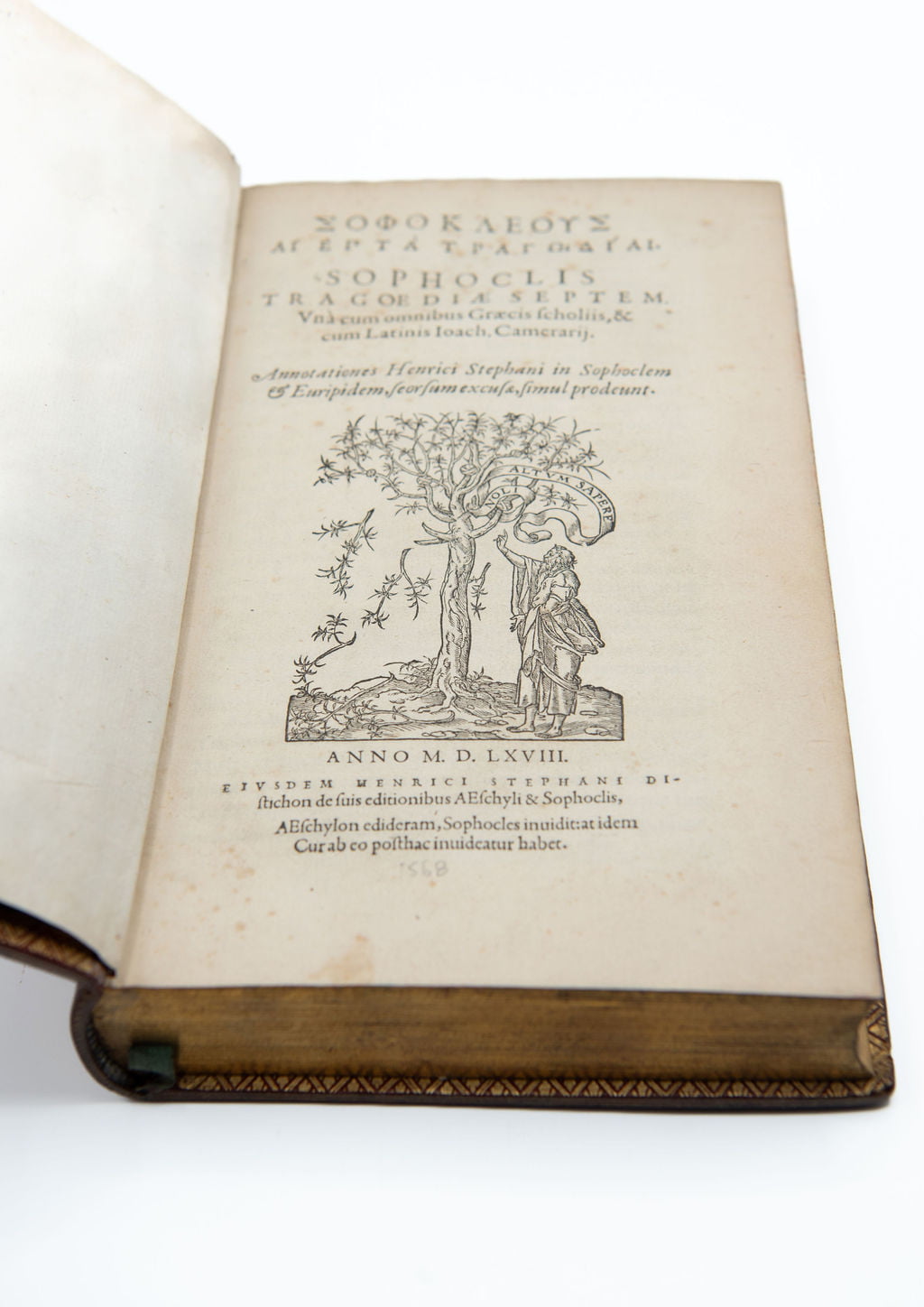SOPHOCLES.
Tragoediae Septem (…) Annotationes Henrici Stephani in Sophoclem et Euripidem
Geneva, Henri II Estienne, 1568£5,750.00
4to, two parts in one, pp. (viii) 461 (i); pp. 142 (ii). Greek and Roman letter, printer’s device to t-p, woodcut floriated initials and headpieces with putti and foliage, text framed by commentary in first part. Slight age yellowing, minor foxing to t-p and next couple of ll., small paper flaw to lower blank margin of some final gatherings. An excellent copy, crisp and clean, in mid. C18 French morocco, covers triple gilt ruled with small flower gilt stamps at corners, spine with gilt raised bands, charming gilt flowers, leaves and pomegranates in compartments, green silk bookmark, marbled endpapers, a.e.g. C20 bookplate to front paste-down.
A splendid copy of this beautifully printed edition of Sophocles’ seven tragedies in Greek. The fine 18th century binding resembles in style the bindings realised by the celebrated French bookbinders Pierre-Paul Dubuisson (1746-1762) and Louis Douceur (d. 1769), particularly for the gilt floral design of the compartments on the spine and the presence of charming pomegranates (for a similar rolls of flowers and pomegranates on Dubuisson’s and Doceur’s bindings, see: Cyclopaedia.org, ‘Pierre-Paul Dubuisson 1757’ and G. Barber, Catalogue of Printed Books and Bookbindings, ROLL 70).
Sophocles (c. 496-406 BC) is one of the greatest ancient Greek tragic playwrights, with Aeschylus and Euripides. Only seven out of more than a hundred plays by him have survived, and they are all included in this volume: ‘Ajax’, ‘Antigone’, ‘Women of Trachis’, ‘Oedipus Rex’, ‘Electra’, ‘Philoctetes’ and ‘Oedipus at Colonus’.
This remarkable edition, “at the present day (…) held in great estimation” (Dibdin), contains the important scholia – explanatory comments – printed in 1518 by Aldus in Rome plus those of Turnebius’ edition of 1554, all revised and corrected by Estienne. The scholia are elegantly printed in a smaller font and frame the tragedies, with occasional indexes pointing to the verses. Appended are additional scholia by the Byzantine philologist Demetrius Triclinius concerning Sophocles’ metre, together with a long erudite commentary by the German classical scholar Joachim Camerarius (1500-1574). Camerarius explains each tragedy in detail, focusing on specific Greek expressions or sentences (provided with page references to the main text). Notably, this final section includes the full Latin translations by Camerarius of Sophocles’ Ajax and Electra. The ‘Annotationes Henrici Stephani in Sophoclem et Euripidem’ (Henry Estienne’s annotations to Sophocles and Euripides), mentioned in the title, appeared in a separate volume in octavo published the same year.
‘A very excellent and accurate edition, and highly creditable to the editorial talents of Henry Stephens […]. It contains some very choice readings: there is not an Edition in which I read Sophocles with so much pleasure as in this…’ (Moss). Henri Estienne (1528-98) had been in Geneva since the late 1550s, when his father, the Royal Printer Robert, abandoned Paris to escape religious persecution, bringing duplicates of the matrices of his famous ‘Grec du roi’ typeface devised by Garamond. Upon Robert’s death in 1559, Henri became official printer of the Republic of Geneva. A fine humanist and prolific author, Henri produced numerous editorial milestones of the Greek classics and the New Testament in Greek.
USTC 450242; Adams S1448; Brunet V, p. 447: “Èdition bien exécutée et réputée correcte”; Graesse VI, p. 440; Renouard 131:3; Dibdin p. 411; Moss II, p. 597.In stock






